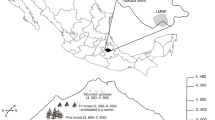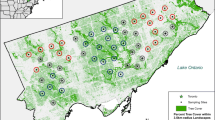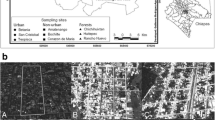Abstract
We studied the occurrence of bats in urban parks in the city of Madrid (Spain), and the resulting patterns were compared with bat occurrence in the surrounding region. In this way, we addressed if the presence of individual species in the study parks was positively related to their regional occurrence and the way some geographical and environmental traits affected bat richness and composition in urban parks. We analysed urban parks varying in area, structure and distance to the edge of the town. During two years, bats occurring in parks were sampled using ultrasound detectors. A similar sampling method was carried out for four years in the countryside around the city to detect the regional pool of species. The results show that the occurrence of individual species in urban parks was a reduced sample of the regional pool of species and that there was a positive relationship between the occurrence of species in urban parks and the surrounding countryside. This pattern suggests that the more distributed bats at a regional scale were the most frequent ones in parks within the urban matrix. Park area was the main determinant of bat richness. In addition, bat richness distribution reported a nested pattern of species loss as park area decreased. This suggests that bat occurrence in the study parks can be interpreted as the results of a passive sampling of individual species occurring at the regional scale, and that park size was the main determinant of the species occurrence. We conclude that more proactive approaches to bat conservation could be carried out in order to improve the presence of some rare species in urban parks.


Similar content being viewed by others
References
Almeida-Neto M, Guimarães Jr PR, Lewinsohn TM (2007) On nestedness analyses: rethinking matrix temperature and anti-nestedness. Oikos, 116(4), 716–722.
Almeida-Neto M, Guimarães P, Guimarães PR, Loyola RD, Ulrich W (2008) A consistent metric for nestedness analysis in ecological systems: reconciling concept and measurement. Oikos 117(8):1227–1239
Altringham JD (2011) Bats: from evolution to conservation. Oxford University Press, Oxford
Ancillotto L, Tomassini A, Russo D (2015) The fancy city life: Kuhl’s pipistrelle Pipistrellus kuhlii benefits from urbanisation. Wildl Res 42(7):598–606
Anderson DR, Burnham KP (2002) Avoiding pitfalls when using information-theoretic methods. J Wildl Manag:912–918
Arias-Aguilar A, Chacón-Madrigal E, Rodríguez-Herrera B (2015) El uso de los parques urbanos con vegetación por murciélagos insectívoros en San José, Costa Rica. Mastozoología neotropical 22(2):229–237
Avila-Flores R, Fenton MB (2005) Use of spatial features by foraging insectivorous bats in a large urban landscape. J Mammal 86(6):1193–1204
Baker PJ, Harris S (2007) Urban mammals: what does the future hold? An analysis of the factors affecting patterns of use of residential gardens in Great Britain. Mammal Rev 37(4):297–315
Barataud M (2012) Ecologie acoustique des chiroptères d’Europe. Biotope Édition, Mèze. Muséum national dHistoire naturelle, Paris.
Bartoń K (2018) MuMIn: multi-model inference. R package version 1,40,4, http://CRAN.R-project.org/package
Bates D, Mächle M, Bolker B Walker S (2014) Fitting linear mixed-effects models using lme4. arXiv preprint arXiv:1406.5823
Caley MJ, Schluter D (1997) The relationship between local and regional diversity. Ecology 78(1):70–80
Collins SL, Glenn SM (1991) Importance of spatial and temporal dynamics in species regional abundance and distribution. Ecology 72(2):654–664
Connor EF, McCoy ED (1979) The statistics and biology of the species-area relationship. Am Nat 113:791–833
De Paz Ó, de Lucas J, Martínez-Alós S, Pérez-Suárez G (2015) Distribución de Quirópteros (Mammalia Chiroptera) en Madrid y Castilla La Mancha España Central. Bol R Soc Esp Hist Nat Sec Biol 109:21–34
Di Salvo I, Russo D, Sarà M (2010) Habitat preferences of bats in a rural area of Sicily determined by acoustic surveys. Hystrix, Italian J Mammal 20(2)
Everette AL, O'Shea TJ, Ellison LE, Stone LA, McCance JL (2001) Bat use of a high-plains urban wildlife refuge. Wildl Soc Bull:967–973
Fernandez-Juricic E, Jokimäki J (2001) A habitat island approach to conserving birds in urban landscapes: case studies from southern and northern Europe. Biodivers Conserv 10(12):2023–2043
Flaquer C, Torre I, Arrizabalaga A (2007) Comparison of sampling methods for inventory of bat communities. J Mammal 88(2):526–533
Gaisler J, Zukal J, Rehak Z, Homolka M (1998) Habitat preference and fight activity of bats in a city. J Zool 244:439–445. https://doi.org/10.1017/S0952836998003148
Gallo T, Lehrer EW, Fidino M, Kilgour RJ, Wolff PJ, Magle S (2017) Need for multiscale planning for conservation of urban bats. Conserv Biol
Garden JG, McAlpine CA, Possingham HP (2010) Multi-scaled habitat considerations for conserving urban biodiversity: native reptiles and small mammals in Brisbane Australia. Landsc Ecol 25(7):1013–1028
Gaston KJ, Blackburn TM, Greenwood JJ, Gregory RD, Quinn RM, Lawton JH (2000) Abundance–occupancy relationships. J Appl Ecol 37(s1):39–59
Gehrt SD, Chelsvig JE (2003) Bat activity in an urban landscape: patterns at the landscape and microhabitat scale. Ecol Appl 13(4):939–950
Gilbert OL (1989) The ecology of urban habitats. Chapman and Hall New York, New York
Hayes JP (2000) Assumptions and practical considerations in the design and interpretation of echolocation-monitoring studies. Acta Chiropterologica 2(2)
Johnson JB, Gates JE, Ford WM (2008) Distribution and activity of bats at local and landscape scales within a rural–urban gradient. Urban Ecosyst 11(2):227
Jung K, Threlfall C.G. (2018) Trait-dependent tolerance of bats to urbanization: a global meta-analysis. Proc R Soc B Biol Sci, 285(1885), 20181222
Jung K, Kaiser S, Böhm S, Nieschulze J, Kalko EK (2012) Moving in three dimensions: effects of structural complexity on occurrence and activity of insectivorous bats in managed forest stands. J Appl Ecol 49(2):523–531
Krauel JJ, LeBuhn G (2016) Patterns of bat distribution and foraging activity in a highly urbanized temperate environment. PLoS One 11(12):e0168927
Kurta A, Teramino JA (1992) Bat community structure in an urban park. Ecography 15(3):257–261
Lomolino MV (1996) Investigating causality of nestedness of insular communities: selective immigrations or extinctions? J Biogeogr 23(5):699–703
McCain CM (2007) Could temperature and water availability drive elevational species richness patterns? A global case study for bats. Glob Ecol Biogeogr 16(1):1–13
Mcguinness KA (1984) Species–area curves. Biol Rev 59(3):423–440
McKinney ML (2002) Urbanization biodiversity and conservation: the impacts of urbanization on native species are poorly studied but educating a highly urbanized human population about these impacts can greatly improve species conservation in all ecosystems. Bioscience 52(10):883–890
Méndez-Nogués D, Martínez-Alós S, Pérez-Súarez G, de Paz O (2016) Análisis comparativo de diferentes índices y software para el estudio de la quiropterofauna a través de sus ultrasonidos. VI Jornadas de la Asociación Española para la Conservación y Estudio de los Murciélagos (SECEMU) 3-4 diciembre 2016, Vairao Portugal
Moretto L, Francis CM (2017) What factors limit bat abundance and diversity in temperate North American urban environments? Journal of Urban Ecology 3(1):jux016
Nicholls B, Racey PA (2006) Contrasting home-range size and spatial partitioning in cryptic and sympatric pipistrelle bats. Behav Ecol Sociobiol 61(1):131–142
Oksanen J, Blanchet FG, Kindt R, Legendre P, Minchin PR,O’Hara RB, Simpson GL, Solymos P, Stevens MHH, Wagner H (2011) Vegan: Community Ecology Package—R packageversion 1,17–8. http://CRAN.R-project.org/package=vegan
Parkins KL, Clark JA (2015) Green roofs provide habitat for urban bats. Global Ecology and Conservation 4:349–357
Patterson BD, Atmar W (1986) Nested subsets and the structure of insular mammalian faunas and archipelagos. Biol J Linn Soc 28(1–2):65–82
Preston FW (1962) The canonical distribution of commonness and rarity: part I. Ecology 43:185–215
R Core Team (2017) R: a language and environment for statistical computing, R Foundation for Statistical Computing Vienna Austria URL https://www.R-project.org/
Rodríguez-Gironés MA, Santamaría L (2006) A new algorithm to calculate the nestedness temperature of presence–absence matrices. J Biogeogr 33(5):924–935
Russo D, Ancillotto L (2015) Sensitivity of bats to urbanization: a review. Mamm Biol 80(3). https://doi.org/10.1016/j.mambio.2014.10.003
Russo D, Jones G (2002) Identification of twenty-two bat species (Mammalia: Chiroptera) from Italy by analysis of time-expanded recordings of echolocation calls. J Zool 258(1):91–103
Russo D, Jones G (2003) Use of foraging habitats by bats in a Mediterranean area determined by acoustic surveys: conservation implications. Ecography 26(2):197–209
Rydell J, Nyman S, Eklöf J, Jones G, Russo D (2017) Testing the performances of automated identification of bat echolocation calls: a request for prudence. Ecol Indic 78:416–420
Schimpp SA, Li H, Kalcounis-Rueppell MC (2018) Determining species specific nightly bat activity in sites with varying urban intensity. Urban Ecosyst 21(3):541–550
Seoane J, Villen-Perez S, Carrascal LM (2013) Environmental determinants of seasonal changes in bird diversity of Mediterranean oakwoods. Ecol Res 28(3):435–445
Uhrin M, Benda P, Kaňuch P (2017) Different responses of attic-dwelling bat species to landscape naturalness. Mammalian Biology-Zeitschrift für Säugetierkunde 82:48–56
Ulrich W, Almeida-Neto M, Gotelli NJ (2009) A consumer's guide to nestedness analysis. Oikos 118(1):3–17
Vaughan N, Jones G, Harris S (1997) Identification of British bat species by multivariate analysis of echolocation call parameters. Bioacoustics 7(3):189–207
Zuur AF, Ieno EN, Elphick CS (2010) a protocol for data exploration to avoid common statistical problems. Methods Ecol Evol 1:3–14
Acknowledgements
This paper was supported by Elena Tena’s contract from the Council for Culture, Education and Sport in the Autonomous Community of Madrid and European Social Fund. We would like to thank all volunteers who helped us with night surveying for bats, especially to Javier Pineda, Cristina Gutiérrez del Álamo, Carmen Soria, Santiago Perea and Carmen Román. We are also grateful to Javier Seoane for helping with the nestedness analysis, to Stewart Finlayson and Tyson Lee Holmes for their support in the review of English, to Octavio Jiménez- Robles for his wise advice, and to the two reviewers that considerably improved an early version of this paper.
Author information
Authors and Affiliations
Corresponding author
Electronic supplementary material
ESM 1
(DOCX 38 kb)
Rights and permissions
About this article
Cite this article
Tena, E., Fandos, G., de Paz, Ó. et al. Size does matter: Passive sampling in urban parks of a regional bat assemblage. Urban Ecosyst 23, 227–234 (2020). https://doi.org/10.1007/s11252-019-00913-2
Published:
Issue Date:
DOI: https://doi.org/10.1007/s11252-019-00913-2




